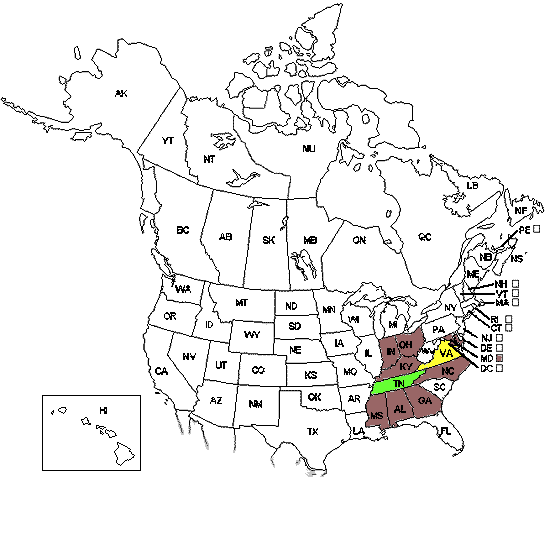
Habitat
Patera laevior are native to the United States and are most commonly found around the southeastern part of the country (NatureServe, 2012). Species have been verified in states ranging from Alabama, Georgia, Indiana, Kentucky, Maryland, Mississippi, North Carolina, Ohio, Tennessee to Virginia (NatureServe, 2012). More specifically, these snail populations are largest in areas such as: Nashville, Tennessee, Mammoth Cave, West Bluff River, Bowling Green, Warren Co., and Burnside, Kentucky, New Albany, Floyd Co., Jeffersonville, and Clark Co., Indiana, and Danville Virginia (Pilsbry, 1940).
Physical barriers that keep species separate from one another include landforms such as the large bodies of water, frozen areas such as mountain tops and glaciers, and dry areas the get little precipitation; land snails require precipitation for respiration and the hatching of eggs (NatureServe, 2012). For different species of slugs and slug-like relatives such as snails, the absence of moisture can also serve as a barrier to movement (NatureServe, 2012).
 Scientists have suggested that refuges may be the single most important
factor that limits terrestrial snail abundance in various
areas (NatureServe,
2012). Patera laevior are often found in places of mixed hardwood
forests, rocky areas, both sandstone and limestone cliff lines,
on steep wooded hillside, along the Kentucky River Palisades,
and along rail road beds in old quarries (Dourson,
2010).
Scientists have suggested that refuges may be the single most important
factor that limits terrestrial snail abundance in various
areas (NatureServe,
2012). Patera laevior are often found in places of mixed hardwood
forests, rocky areas, both sandstone and limestone cliff lines,
on steep wooded hillside, along the Kentucky River Palisades,
and along rail road beds in old quarries (Dourson,
2010).
Some threats that gastropods face include dangers such as forest fires, logging, mining exploration, as well as herbicide and pesticide spraying (Lowe et al., 1990). Common predators of gastropods include animals such as snakes, salamanders, ground rodents, insects, and beetles (Lowe et al., 1990).
